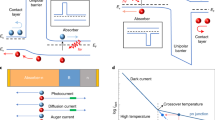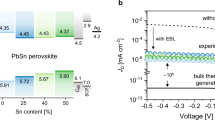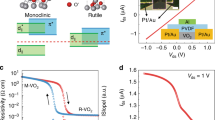Abstract
Infrared photodetectors are currently subject to a rapidly expanding application space, with an increasing demand for compact, sensitive and inexpensive detectors. Despite continued advancement, technological factors limit the widespread usage of such detectors, specifically, the need for cooling and the high costs associated with processing of iii–v/ii–vi semiconductors. Here, black phosphorous (bP)/MoS2 heterojunction photodiodes are explored as mid-wave infrared (MWIR) detectors. Although previous studies have demonstrated photodiodes using bP, here we significantly improve the performance, showing that such devices can be competitive with conventional MWIR photodetectors. By optimizing the device structure and light management, we demonstrate a two-terminal device that achieves room-temperature external quantum efficiencies (ηe) of 35% and specific detectivities (D*) as high as 1.1 × 1010 cm Hz1/2 W−1 in the MWIR region. Furthermore, by leveraging the anisotropic optical properties of bP we demonstrate the first bias-selectable polarization-resolved photodetector that operates without the need for external optics.
This is a preview of subscription content, access via your institution
Access options
Access Nature and 54 other Nature Portfolio journals
Get Nature+, our best-value online-access subscription
$29.99 / 30 days
cancel any time
Subscribe to this journal
Receive 12 print issues and online access
$209.00 per year
only $17.42 per issue
Buy this article
- Purchase on Springer Link
- Instant access to full article PDF
Prices may be subject to local taxes which are calculated during checkout





Similar content being viewed by others
References
Xia, F., Wang, H., Xiao, D., Dubey, M. & Ramasubramaniam, A. Two-dimensional material nanophotonics. Nat. Photon. 8, 899–907 (2014).
Jakšić, Z. Micro and Nanophotonics for Semiconductor Infrared Detectors (Springer, Basel, 2014).
Rogalski, A., Adamiec, K. & Rutkowski, J. Narrow-Gap Semiconductor Photodiodes (SPIE, Bellingham, WA, 2000).
Wang, X., Cheng, Z., Xu, K., Tsang, H. K. & Xu, J.-B. High-responsivity graphene/silicon-heterostructure waveguide photodetectors. Nat. Photon. 7, 888–891 (2013).
Xia, F., Wang, H. & Jia, Y. Rediscovering black phosphorus as an anisotropic layered material for optoelectronics and electronics. Nat. Commun. 5, 5458 (2014).
Ling, X., Wang, H., Huang, S., Xia, F. & Dresselhaus, M. S. The renaissance of black phosphorus. Proc. Natl Acad. Sci. USA 112, 4523–4530 (2015).
Yuan, H. et al. Polarization-sensitive broadband photodetector using a black phosphorus vertical p–n junction. Nat. Nanotech. 10, 707–713 (2015).
Qiao, J., Kong, X., Hu, Z.-X., Yang, F. & Ji, W. High-mobility transport anisotropy and linear dichroism in few-layer black phosphorus. Nat. Commun. 5, 5475 (2014).
Hong, T. et al. Anisotropic photocurrent response at black phosphorus–MoS2 p–n heterojunctions. Nanoscale 7, 18537–18541 (2015).
Deng, Y. et al. Black phosphorus–monolayer MoS2 van der Waals heterojunction p–n diode. ACS Nano 8, 8292–8299 (2014).
Ye, L., Li, H., Chen, Z. & Xu, J. Near-infrared photodetector based on MoS2/black phosphorus heterojunction. ACS Photon. 3, 692–699 (2016).
Chen, P. et al. Gate tunable WSe2–BP van der Waals heterojunction devices. Nanoscale 8, 3254–3258 (2016).
Shim, J. et al. Phosphorene/rhenium disulfide heterojunction-based negative differential resistance device for multi-valued logic. Nat. Commun. 7, 13413 (2016).
Huang, M. et al. Broadband black-phosphorus photodetectors with high responsivity. Adv. Mater. 28, 3481–3485 (2016).
Youngblood, N., Chen, C., Koester, S. J. & Li, M. Waveguide-integrated black phosphorus photodetector with high responsivity and low dark current. Nat. Photon. 9, 247–252 (2015).
Guo, Q. et al. Black phosphorus mid-infrared photodetectors with high gain. Nano Lett. 16, 4648–4655 (2016).
Mao, N. et al. Optical anisotropy of black phosphorus in the visible regime. J. Am. Chem. Soc. 138, 300–305 (2016).
Liu, H. et al. Phosphorene: an unexplored 2D semiconductor with a high hole mobility. ACS Nano 8, 4033–4041 (2014).
Tran, V., Soklaski, R., Liang, Y. & Yang, L. Layer-controlled band gap and anisotropic excitons in few-layer black phosphorus. Phys. Rev. B 89, 235319 (2014).
Li, D. et al. Polarization and thickness dependent absorption properties of black phosphorus: new saturable absorber for ultrafast pulse generation. Sci. Rep. 5, 15899 (2015).
Macleod, A. Thin-Film Optical Filters (CRC, Boca Raton, FL, 2010).
Villegas, C. E. P., Rocha, A. R. & Marini, A. Anomalous temperature dependence of the band gap in black phosphorus. Nano Lett. 16, 5095–5101 (2016).
Villegas, C. E. P., Rodin, A. S., Carvalho, A. & Rocha, A. R. Two-dimensional exciton properties in monolayer semiconducting phosphorus allotropes. Phys. Chem. Chem. Phys. 18, 27829–27836 (2016).
Li, L. et al. Quantum Hall effect in black phosphorus two-dimensional electron system. Nat. Nanotech. 11, 593–597 (2016).
Martyniuk, P., Kopytko, M. & Rogalski, A. Barrier infrared detectors. Opto-Electron. Rev. 22, 127–146 (2014).
Dhar, N. K., Dat, R. & Sood, A. K. in Optoelectronics—Advanced Materials and Devices Ch. 7 (InTech, London, 2013).
Amani, M., Regan, E., Bullock, J., Ahn, G. H. & Javey, A. Mid-wave infrared photoconductors based on black phosphorous–arsenic alloys. ACS Nano 11, 11724–11731 (2017).
Buscema, M. et al. Fast and broadband photoresponse of few-layer black phosphorus field-effect transistors. Nano Lett. 14, 3347–3352 (2014).
Martyniuk, P. & Rogalski, A. HOT infrared photodetectors. Opto-Electron. Rev. 21, 239–257 (2013).
Yau, L. D. & Sah, C.-T. Theory and experiments of low-frequency generation–recombination noise in MOS transistors. IEEE Trans. Electron. Devices 16, 170–177 (1969).
Long, M. et al. Room temperature high-detectivity mid-infrared photodetectors based on black arsenic phosphorus. Sci. Adv. 3, e1700589 (2017).
Haddadi, A., Dehzangi, A., Chevallier, R., Adhikary, S. & Razeghi, M. Bias–selectable nBn dual-band long-/very long-wavelength infrared photodetectors based on InAs/InAs1−xSbx/AlAs1−xSbx type-II superlattices. Sci. Rep. 7, 3379 (2017).
Bullock, J., Cuevas, A., Allen, T. & Battaglia, C. Molybdenum oxide MoOx: a versatile hole contact for silicon solar cells. Appl. Phys. Lett. 105, 232109 (2014).
Chuang, S. et al. MoS2 p-type transistors and diodes enabled by high work function MoOx contacts. Nano Lett. 14, 1337–1342 (2014).
Low, T. et al. Tunable optical properties of multilayer black phosphorus thin films. Phys. Rev. B 90, 075434 (2014).
Morita, A. Semiconducting black phosphorus. Appl. Phys. A 39, 227–242 (1986).
Huang, Y. et al. An innovative way of etching MoS2 characterization and mechanistic investigation. Nano Res. 6, 200–207 (2013).
Acknowledgements
The authors thank P. Wijewarnasuriya and E. DeCuir from the US Army Research Laboratory for discussions. This work was supported by the Defence Advanced Research Projects Agency under contract no. HR0011-16-1-0004. K.B.C. acknowledges funding from the Australian Research Council (DP150103736 and FT140100577) and an Innovation Fellowship from the Victorian Endowment for Science, Knowledge and Innovation (VESKI).
Author information
Authors and Affiliations
Contributions
J.B., M.A. and A.J. conceived the idea for the project and designed the experiments. J.B. and M.A. performed optical measurements. M.A., J.B., J.C. and G.H.A. fabricated devices. V.A. performed device simulations. Y.-Z.C. and Y.-L.C. performed TEM measurements. J.B, M.A., V.A., V.R.S., Y.G., K.B.C. and A.J. analysed the data. J.B., M.A. and A.J. wrote the manuscript. All authors discussed the results and commented on the manuscript.
Corresponding author
Ethics declarations
Competing interests
The authors declare no competing interests
Additional information
Publisher’s note: Springer Nature remains neutral with regard to jurisdictional claims in published maps and institutional affiliations.
Supplementary information
Supplementary Information
This file contains Supplementary Figures and additional information about the work such as photodiode fabrication and performance and laser diode characterization
Rights and permissions
About this article
Cite this article
Bullock, J., Amani, M., Cho, J. et al. Polarization-resolved black phosphorus/molybdenum disulfide mid-wave infrared photodiodes with high detectivity at room temperature. Nature Photon 12, 601–607 (2018). https://doi.org/10.1038/s41566-018-0239-8
Received:
Accepted:
Published:
Issue Date:
DOI: https://doi.org/10.1038/s41566-018-0239-8
This article is cited by
-
Photogating-assisted tunneling boosts the responsivity and speed of heterogeneous WSe2/Ta2NiSe5 photodetectors
Nature Communications (2024)
-
Synergistic-potential engineering enables high-efficiency graphene photodetectors for near- to mid-infrared light
Nature Communications (2024)
-
In-situ fabrication of on-chip 1T’-MoTe2/Ge Schottky junction photodetector for self-powered broadband infrared imaging and position sensing
Nano Research (2024)
-
Mid-infrared single-pixel imaging at the single-photon level
Nature Communications (2023)
-
High-performance broadband flexible photodetector based on Gd3Fe5O12-assisted double van der Waals heterojunctions
Microsystems & Nanoengineering (2023)



